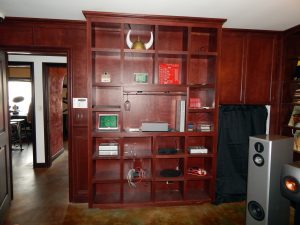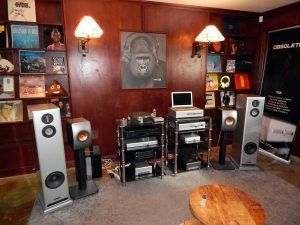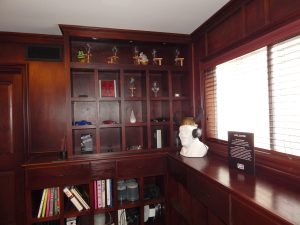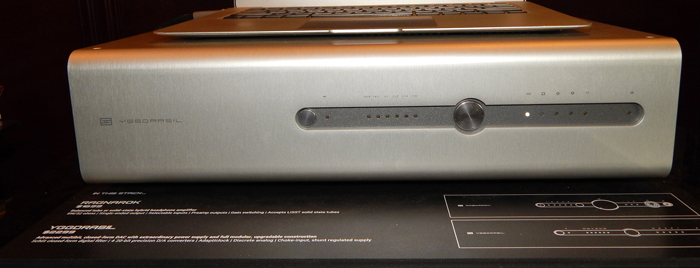Over the years Schiit has developed a reputation for four things; extreme value, high performance, US manufacture and total irreverence. What many may not know is that Mike Moffat (the digital designer for Schiit) was one of the seminal forces in high-end digital audio. At a time when almost all high end CD player designers were simply modifying the analog section of an off the shelf version of one of the mass market CD players, Mike was looking at the front end, the actual digital to analog conversion process developing what was probably the finest DAC of its day. I am one of the privileged few who were actually able to hear his “Frankenstein” CD player that led up to the creation of Theta Digital, and at that time, there was nothing that even came close to it in performance, so it was of no surprise to me that Schiit quickly jumped to the front as one of the top DAC manufacturers in personal audio.
Why Multibit:
The designers at Schiit are not fans of Sigma Delta DACs, and for good reason. To explain why I need to get a wee bit technical, but as I am not a digital engineer, not overly so. PCM bitstreams (standard digital audio) are generally made up of 8, 16, 18, 24 or 32 bit words, each word representing a point along the musical sine wave. The number of bits in the word determines two things; how much dynamic range you have and how accurate your plot is (each bit increases your accuracy by a factor of two, IE: 1 bit has 2 possible values, 2 bits have 4 possible values, 3 bits have 8 and so forth so 16 bits have 65536 possible values and 24 bits have 16777216 possible values) and the number of plot points (words) is determined by the sample rate measured in samples per second, which is why digital audio is expressed as a two number combination (IE: 16(bit)/44.1 kHz (samples)). Sigma Delta on the other hand treats each bit in the data stream as a separate sample which creates a certain fudge factor as each bit either raises or lowers the plot point by 1 which means the point in between cannot be expressed and there is not a clean sample point.


The Schiit Store:
Since it is only 45 minutes away, I met with Denise Martin at the Schiit retail outlet in Newhall, CA to pick up the Yggy (the Yggdrasil’s nickname, as Yggdrasil doesn’t exactly roll off the tongue unless you’re Norse) and I have to say I was impressed. It was very homey and quirky, much like the company principles themselves, a relaxed and comfortable environment in which to experience the entire Schiit line, if you live in the LA area I whole heartedly recommend a visit.


The Hardware:
Before we get into the meat of what it sounds like, I’ll cover a little of the nuts and bolts of features and construction. For those who haven’t seen one in person, the Yggy is big in personal audio terms, about the size of a full sized audio receiver 16 x 12” x 3.875”. The chassis is made from an 1/8″ thick sheet of rolled aluminum bent into a U to form a cover over separate sides, bottom and back producing a sense of elegance and sturdiness. On the back you have two sets of single ended outputs (RCA) and one set of balanced outputs (XLR). For inputs you have USB, RCA SPDIF, BNC SPDIF, Optical SPDIF, and AES/EBU XLR making the Yggy appropriate for Pro use as well as audiophile home use. The power switch is also on the back implying that it is recommended that it be left on. On the front you have only two buttons, Input Select and my favorite DAC special feature, Phase Invert (for those unfamiliar with the “Wood Effect”, absolute phase – the phase of the signal in relation to the listener as opposed to channel phase which is the phase of the left and right channels in relation to each other – can make a significant impact on the tonal balance and soundstage, in fact in Dolby surround the rear channels are created by putting the rear channel information 180° out of phase. Unlike analog recordings which can have a full range of phase shift, digital recordings tend to be in phase or 180° out of phase – phase can be reversed at several points in the record/playback process, including in the DAC itself or even in the amplifier or speakers. I believe that a Phase Invert switch should be included on all DACs). For indicators there are simple lights for Phase Invert, Sample Rate (which is indicated by two lights, one for base frequency of 44.1 kHz or 48 kHz and one for multiplier of 1x, 2x, 4x and 8x) and VCO/VCXO (which indicates a clock error on the input signal requiring VCO mode).
For technical features you have: Bitperfect clock management at all native sample rates via Adapticlock analysis and VCXO/VCO regeneration, plus an asynchronous USB Gen 5 module. A proprietary Schiit bitperfect closed-form digital filter implemented on an Analog Devices SHARC DSP processor which gives you the best of both NOS (all original samples retained) and upsampling (easier filtering of out-of-band noise) designs. Four Analog Devices AD5791BRUZ multibit digital to analog converter chips. Fully discrete, DC coupled Class A FET buffers optimized for high current output with fully discrete, Class A FET summing stages for single-ended output. Two transformers (one for digital supplies, one for analog supplies) plus one input choke for discrete, dual mono, shunt-regulated analog +/-24V supply, plus 12 separate local regulated supplies for DACs and digital sections, including high-precision, low-noise LM723 regulation in critical areas. And a fully modular architecture to simplify upgrades (IE: Separate digital input board, USB input board, DSP engine board, and DAC/analog output boards).
Listening Tests:
Of course, all of the above is meaningless if the Yggy doesn’t deliver, so it was time to put it through its paces. Since we are looking at a reference level piece of gear here, I only tested it with my reference pieces, which in this case meant connecting via the balanced outputs to my two Questyle CMA 800R Current Mode amplifiers in a dual mono balanced configuration to my MrSpeakers ETHER C Flow headphones, using my Linux box as source via USB using a program called DeaDBeef.
As is my wont when testing reference gear I began with a 24/96 kHz vinyl rip of Robert Shaw and the Atlanta Symphony Orchestra’s rendition of Stravinsky’s “The Firebird Suite” looking for what I call the “Chill Test” (Essentially there is a passage when rendered with high enough resolution sends chills up my spine). I am happy to say the Yggy passed with flying colors. I repeated the test with the 16/44.1 kHz CD version of the track and was pleasantly surprised to find only a little difference between the two recordings. While the vinyl version offered a larger presentation, the CD version had much greater dynamic range with a significantly lower noise floor. In both cases the soundstage was huge, with excellent attack to the crescendos. The imaging and instrument placement was pinpoint and the resolution was glorious even with the 44.1 track. The triangle stood out clear against a background of tympanis and horns, which themselves had a very organic feel. The tonality of the instruments was perfect, allowing for easy identification with the multitude of similar sounding instruments like the French horn, the oboe, the clarinet and the flute.
“The Court of the Crimson King” by King Crimson (In the Court of the Crimson King – 24/96 kHz) offers one of the most complex layerings of acoustic and electric instruments in rock music. The Yggdrasil eked every minute nuance, painting a realistic tapestry of lifelike musicality against complete blackness in an epic hall. The attack and decay of the cymbals and bells stark and solid, with an immense amount of air surrounding each tap of the drum stick, silence as much a musical note as the riveting crescendos. Breath across the flute palpable as was the emotion in Greg Lake’s voice.
For piano I turned to Emerson, Lake and Palmer’s “Take a Pebble” (Emerson, Lake and Palmer – 24/48 kHz). The depth and width of the soundstage surrounding the lovingly rendered Steinway was epic. The bass guitar was tight with a rarely seen depth, and as with everything I listened to the percussion was blisteringly fast.
The Takeaway:
Schiit have done their job. As a reference piece the Yggy Analog 2 delivers in spades. For detail and musicality, I have not heard better. The large deep soundstage speaks of levels of resolution not achievable with Sigma/Delta DAC chips when reproducing PCM. The incredible neutrality of the tonal balance says the Yggy adds nothing that does not belong there to the music. If I have any complaint it is that the presentation is sometimes a little more crisp than I prefer being an analog and tube guy at heart, but that being said, I have listened to $50,000 DACs that I can’t say sound better. If you are in the market for a reference DAC, or simply have the cash for one, you would be doing yourself a disservice to not audition the Schiit Yggdrasil Analog 2.


http://www.schiit.com/products/yggdrasil
Price: $2,399
Specs:
Inputs: AES/EBU XLR, RCA SPDIF, BNC SPDIF, Optical SPDIF, USB
Input Capability: up to 24/192 for all inputs
Input Receiver, SPDIF: AKM AK4113
Input Receiver, USB: C-Media CM6631A
Clock Management: Bitperfect clock management at all native sample rates via Adapticlock analysis and VCXO/VCO regeneration, plus asynchronous USB Gen 5 module
Digital Filter: proprietary Schiit bitperfect closed-form digital filter implemented on Analog Devices SHARC DSP processor
D/A Conversion IC: Analog Devices AD5791BRUZ x 4 (2 per channel, hardware balanced configuration)
Analog Stage: Fully discrete, DC coupled Class A FET buffers optimized for high current output and fully discrete, Class A FET summing stages for single-ended output
Output: One pair XLR balanced and two pairs RCA single-ended
Output Impedance: 75 ohms
Frequency Response, Analog Stage: 20Hz-20Khz, +/-0.1dB, 0.5Hz-200KHz, -1dB
Maximum Output: 4.0V RMS (balanced), 2.0V RMS (single-ended)
THD: Less than 0.005%, 20Hz-20KHz, at full output
IMD: <0.005%, CCIF, at full output SNR: > 119dB, referenced to 2V RMS
Power Supply: two transformers (one for digital supplies, one for analog supplies) plus one input choke for discrete, dual mono, shunt-regulated analog +/-24V supply, plus 12 separate local regulated supplies for DACs and digital sections, including high-precision, low-noise LM723 regulation in critical areas.
Upgradability: Fully modular architecture. Separate digital input board, USB input board, DSP engine board, and DAC/analog output boards.
Power Consumption: 35W
Size: 16 x 12” x 3.875”
Weight: 25 lbs


















Want to join discussion?
Feel free to contribute!